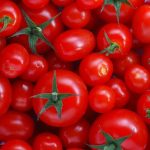
Vegetables are part of a healthy, balanced diet so we must eat enough of them. Most vegetables are a great source of vitamins, minerals, dietary fibre and other nutrients. Additionally, they are almost always low in fat and calories. It’s universally recommended by various health organisations around the world that we eat at least 400g (5 portions) of fruit and vegetables per day. Medical experts promote this as a way of warding off some preventable serious health issues such as heart disease, strokes and some types of cancer.
Potatoes, carrots, onions, broccoli, cauliflower and cabbage are the main vegetable staples of the Western diet. However, the number of different types of vegetables cultivated and consumed globally runs to tens of thousands. Here’s a brief narrative on five scrumptious exotic vegetables that you might want to try:
Oca
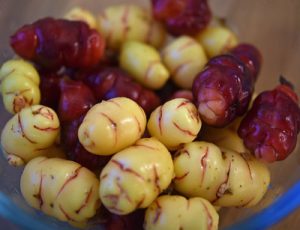
Photo credit: Flickr/CC BY 2.0 DEED
Oca (Oxalis tuberosa), not to be confused with “okra”, is an edible tuber that originates in the central region of the Andes. Now a popular staple in the Antipodes, it is also known as the New Zealand yam. Botanically, oca belongs to the genus “Oxalis”, a large family of wood-sorrel flowering plants.
The perennial tuber, known as “uqa” in Spanish, has been a popular stable in the rural Andes for millennia. The starchy winter vegetable is highly nutritious and easy to cultivate, flourishing at altitude, in poor soil, and in harsh climates. Cultivated over the centuries, many species of oca are now grown worldwide in an array of colours and flavours.
Ate raw and unpeeled, oca has a sweet, tangy, nutty flavour, that is largely retained after cooking. Prepared exactly like potatoes, oca can be boiled, baked, roasted, or fried. The vegetable can also be added to salads, soups, stews, or mashed.
Jimaca
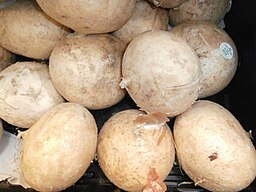
Photo credit: Wikimedia/CC0 1.0 Universal
Jimaca (Pachyrhizus erosus) is a bulbous, tuberous vegetable that originates from Mexico. However, it is now also grown in the warm regions of Central America, the Caribbean, the Andes, and Southern Asia. Part of the legume (pea) family, the jimaca plant grows on vines.
The Spaniards took the vegetable to the Philippines in the 16th century, which later saw it cultivated throughout the rest of Southeast Asia and China. Jimaca’s alternative names include the Mexican turnip, the Mexican potato, the Chinese potato, and the sweet turnip. The tuberous root vegetable has a texture that is similar to a turnip but tastes something close to an apple.
Jimaca can be eaten raw or cooked but its thick, papery skin must be removed first. When raw it is usually eaten in sticks, similar to a carrot, or added to a salad. Commonly made into a sauce or a salsa, it is also popularly added to soups or stir-fries.
Kohlrabi
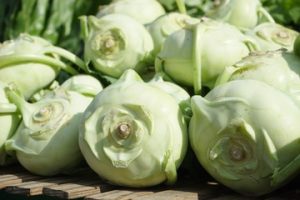
Photo credit: PxHere/CC0 1.0 Public Domain
Kohlrabi (Brassica oleracea) is a member of the Brassica family that includes both turnips and cabbage and the likes of broccoli, cauliflower, kale and Brussels sprouts. Though unrelated to the turnip family, its name translates to English as “turnip cabbage”. Kohlrabi’s other popular European name is the German turnip.
Kohlrabi is thought to be a cultivar of the wild marrow cabbage found in numerous coastal locations around Europe. Its first recorded culinary use is in Italy during the mid-16th century. By the end of the century, its consumption had pretty much spread across the rest of Europe. Today, the biennial vegetable is most readily consumed in Southern Asia, parts of SE Asia and Eastern Europe.
The kohlrabi’s raw bulb tastes somewhere between turnip and water chestnut. The versatile vegetable has a mild, sweet flavour with a crispy, crunchy texture and is commonly eaten raw in salads or slaws. Thin bulb slices can be sautéed for soups or added to stir-fries. Thick chunks of kohlrabi can be roasted or added to stews. The leaves can be cooked the same as way as other brassicas and taste similar to broccoli.
Romanesco
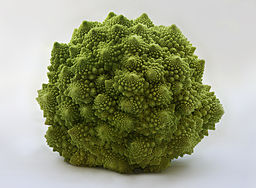
Photo credit: Wikimedia Commons/CC BY-SA 2.5
Romanesco is an edible flower bud of the botanical species Brassica oleracea. The cauliflower cultivar is commonly known as Romanesco broccoli or Romanesque cauliflower, as well as many other names. While appearing somewhat similar to the cauliflower, the bud is a distinctive yellowish-green and takes a natural fractal* form.
Romanesco was first cultivated in the Lazio region of Italy as early as the 15th century. Thus, the vegetable took its name from the region’s capital, Rome. However, the unusual-looking was not introduced to much of the world, including the USA, until the early 20th century. Romanesco is now grown in many of the world’s temperate regions, in various colours including orange, yellow and purple.
Romanesco has a distinctive sweet, earthy, nutty flavour and crunchy texture. It is usually prepared for consumption in the same way as its cauliflower cousin. Thus, the florets are most commonly roasted, boiled, steamed or added to stir-fries. The leaves can be wilted and eaten like any other greens. The stalk is also perfectly edible, normally prepared as the florets and sliced into batons.
*a mathematical term to describe a geometric figure featuring recurring intricate patterns of various sizes.
Yard-long Beans
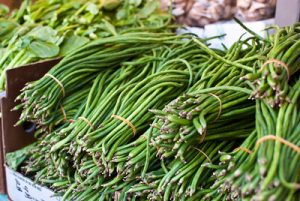
Photo credit: Flickr/CC BY-NC-SA 2.0
The yard-long bean (Vigna unguiculata) pod will grow to a yard (90 cm) long but the beans are at their best when the pods reach about a foot (30 cm) in length. The legume is alternatively known as the asparagus bean, Chinese long bean, long-podded cowpea and snake bean.
The annual climbing vine is thought to be first referenced in 11th-century Chinese literature. However, the species also has botanical connections to tropical Africa. The vigorously growing yard-long bean is now ubiquitously cultivated but best suited to subtropical and tropical climates. Thus, it is predominantly grown in South and Southeast Asia, Southern China, Africa and South America.
The yard-long bean pods are at their best when young and tender. They are often consumed in the same way as green beans and can be eaten fresh or cooked. The bean pods are frequently cut into convenient short sections for cooking purposes. The beans are prominent in Chinese, Thai, Caribbean, and Indian cuisines.
Header image credit: Flickr/CC BY-NC-ND 2.0
